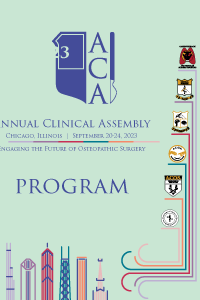General Surgery
An Analysis of Osteopathic Medical Students Applying to Surgical Residencies Following Transition to a Single Graduate Medical Education Accreditation System
- TS
Thomas Scully, MS
Student
University of Incarnate Word School of Osteopathic Medicine
San Antonio, Texas, United States
Poster Presenter(s)
Introduction: Upon requests from Osteopathic medical schools, the NRMP Charting Outcomes were redesigned to include osteopathic medical school seniors beginning in 2018 and one joint graduate medical education accreditation system, the Accreditation Council for Graduate Medical Education (ACGME), formed in 2020.
Purpose: The goal of this study is to analyze the match outcomes and characteristics of osteopathic applicants applying to surgical specialties following the ACGME transition.
Methods or Case Description:
Methods: A retrospective analysis of osteopathic senior match outcomes in surgical specialties from the National Resident Matching Program (NRMP) Main Residency Match data from 2020-2022 and the NRMP Charting Outcomes data from 2020-2022 was performed.
Outcomes:
Results: For surgical specialties, results show matching increased as USLME Step 2-CK and COMLEX Level 2-CE scores increased along with the number of contiguous rankings (p < .001). The greatest indication for matching looking at scores alone were those who scored greater than 230 on Step 2-CK compared to below (p < .001) and above 650 on Level 2-CE (p < .001). However, those who scored 240 (p=.025) on Step 2-CK were just as likely to match as those who scored 250 (p=.022) when compared to those who scored below those scores. Increasing research involvement had little to no significance with the likelihood of matching across most surgical subspecialties.
Conclusion:
Conclusion: Matching into surgical specialties is multifactorial for osteopathic applicants, highlighting that residency selection committees are embracing a more holistic evaluation. Given the disparate information present, further study into the number of auditions, letters of recommendation, and impact of preference signaling in combination with the NRMP data is needed to understand how these may play a role in matching for osteopathic applicants.

